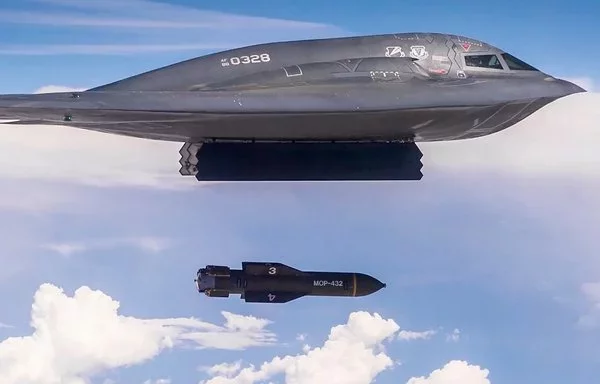The US Air Force can arm its B-2 Spirit stealth bomber with a formidable, 14,000kg "bunker buster" bomb, a potent non-nuclear option that can neutralize deeply buried underground facilities.
The B-2 bomber, renowned for its stealth technology, is capable of carrying up to two GBU-57A/B Massive Ordnance Penetrator (MOP) bunker busters.
The MOPs are formidable weapons. The precision-guided munitions, each weighing a staggering 14,000kg, are intended to penetrate and destroy hardened bunkers.
The bomb is engineered to burrow through layers of reinforced concrete and steel before detonating, enabling it to inflict catastrophic damage on even the most hardened and deeply buried targets.
Each MOP can penetrate up to 61 meters of earth and reinforced concrete, with the potential penetration depth increasing with multiple strikes, though the exact figures remain classified.
The GBU-57 is both larger and more powerful than its predecessor, the BLU-109, and is designed to accomplish the difficult mission of reaching and destroying weapons of mass destruction (WMDs) in well-protected facilities.
The MOP has been in service since 2011, with the US Air Force initially receiving 20 units.
Over the years, Congress has supported the Air Force's acquisition requests for the MOP, suggesting that the stockpile of these bombs potentially numbers in the hundreds.
'Invisible'
The combination of the B-2 Spirit and the MOP is tailored to accomplish complex missions that require precision and power.
This capability is particularly significant given increasing concerns over fortified underground facilities suspected of housing WMD programs in well-protected areas with robust air defenses.
There are an estimated 20 B-2s in service, which the Air Force plans to operate until at least 2032, when it will replace them with the B-21 Raider.
The 34-year-old bomber was a generation ahead of its time. The materials coating the aircraft, combined with the shape of the airframe and engine inlets, render it virtually "invisible" to radar and other sensors.
Undetected, the B-2 can destroy high-value, and even heavily defended, targets deep in enemy territory with little to no warning.
The B-2's stealth means it does not need as many supporting aircraft as other bombers do for air cover, Suppression of Enemy Air Defenses or electronic countermeasures, making the bomber a "force multiplier."
The bomber can drop conventional and thermonuclear weapons, such as up to 80 230kg class MK-82 Joint Direct Attack Munition (JDAM) Global Positioning System-guided bombs, or 16 1,100kg B83 nuclear bombs.
It can perform ultra-high-altitude attack missions at up to 15,000 meters, has an unrefueled range of more than 11,000km and can fly more than 19,000km with one midair refueling.







Could you tell us about the Russian and North Korean weapons, or are they still using catapults in wars?
ReplyThis is propaganda for a double standard country that claims to be defending human rights.
ReplyMay Allah avenge them! They're only inventing bombs and missiles and destroying everything, including plants, humans and animals. They're like Dracula; they're never satisfied with blood. May Allah make us see our revenge against them and destroy their strength!
Reply